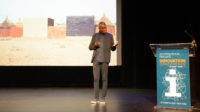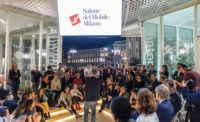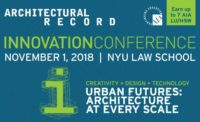For the hundreds of architects and others who gathered at New York University’s law school auditorium on November 1 for Architectural Record’s annual Innovation Conference, the day served as a crash course of sorts. Titled “Urban Futures: Architecture at Every Scale,” the event showcased the insights and work of a diverse group of professionals, presenting a wide range of ways that technology is set to transform cities across the globe.
Kicking off the conference, Andy Cohen, co-CEO of Gensler, focused on the reality of a future with fewer cars (attributable to the rise of autonomous vehicles and services like Lyft and Uber) and the implications for the built environment. For example, buildings will soon need larger pick-up and drop-off areas but far fewer parking spaces; Gensler is already advising clients who require parking to build above-ground structures that can be converted to hotels or offices. On an urban scale, millions of acres now devoted to parking will also be repurposed, potentially as green space. Given the design possibilities, Cohen said, “This is a crucial moment for everyone in the room.”
Gensler’s extensive investment in research is one example of how architects can get ahead of technological change. Michael Green, principal of Vancouver firm Michael Green Architecture, presented another way at the conference. Observing how giant tech companies are beginning to revolutionize architecture and construction “we decided we wanted to be insiders,” said Green, who in May sold his firm to the Silicon Valley start-up Katerra. Katerra, valued at $3 billion, plans to reduce building costs by 30 percent by bringing the efficiencies of precision manufacturing to the construction industry. Green’s experience working with mass timber is now part of the knowledge-base that could help Katerra scale up.
Gordon Gill, founding partner of Chicago’s Adrian Smith + Gordon Gill Architecture, knows about scale; his firm has designed some of the world’s tallest buildings. But he spoke passionately about its efforts to improve life on the ground. In Astana, Kazakhstan, his team master-planned a world expo site that incorporates a large residential development. Gill spoke of details such as an app that lets residents know when a bus is coming, so they don’t have to wait outside in the extreme cold. The firm, which in 2011 released a plan for the “decarbonization” of downtown Chicago, is about to publish a book about the relationship between residential densities of differing typologies and their respective carbon footprints.
Several architects spoke of ways they are making big cities greener. Winy Maas, principal architect and urbanist at the Rotterdam firm MVRDV, helped turn a 1970s highway overpass in Seoul into an elevated park, a place, he said, “where you want to float over the traffic.” Thirty feet wide and 3,000 feet long, the park owes a debt to New York’s High Line; now MVRVD is planning elevated parks in Glasgow and Rotterdam while plotting the extension of the Seoul walkway into an urban-scaled network of pedestrian spaces. Adam Greenspan, a design partner at PWP Landscape Architecture in Berkeley, California, is also part of the elevated park “movement.” In his talk, Greenspan showed the park he recently completed atop the new Sales Force Transit Center in San Francisco. Though the building and park have been temporarily closed—due to a cracked girder—the green space is still a refuge for “flying members of San Francisco society,” he said, referring to the local bird and butterfly population. Similarly, Greenspan noted, his firm’s new water court at Glenstone—a contemporary art museum set within a bucolic landscape by PWP in Potomac Maryland—“was designed for the people who look at it, but also for the plants that live in it.”
V. Mitch McEwen, principal of McEwen Studio, co-founder of A(n) Office (a collaborative of design studios in Detroit and New York), and a Princeton architecture professor, presented her ideas for treating empty lots in Detroit as communal green spaces, given, she said, that the sharp divide between public street and private house “is no longer operative.” John Ronan, founding principal of John Ronan Architects, discussed another binary: inside versus outside. “I’m interested in ambiguity,” said Ronan, who has included sheltered open spaces in several Chicago projects. One is a building designed at the behest of Chicago mayor Rahm Emanuel, who had the idea to combine affordable housing with branch libraries. The residential portion of Ronan’s building has a multicolored facade, a deliberate response to the typically dehumanizing, undifferentiated faces of the last generation of public housing. “We want people to be able to say, ‘That green balcony, that’s my home,’” said Ronan.
Carme Pinós, founder of Barcelona’s Estudio Carme Pinós, also explored ideas of home with her competition-winning project for a school and housing block behind the city’s Boqueria market. “I try to connect,” she said, referring to the ways her site plan preserves pedestrian paths through the old city. Architecturally, her addition to the nearby market hall, she said, looks “as if it had been there already,” while her new buildings echo the existing urban fabric. Pinós’s work could be a case in point for author Sarah Williams Goldhagen, whose principles of “human centered design,” include using materials with rich patterns and textures.
By the time the Innovation conference drew to an end, a shared message had become clear: New ideas can improve the world’s cities so long as they prioritize the human experience.














Post a comment to this article
Report Abusive Comment